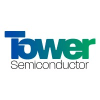
Tower Semiconductor Ltd.
TSEM
Market Cap$4.41B
Close$
$25.62 40.2% downside
40.2% downside
Current Fair Value
Overvalued by 40.2% based on the discounted cash flow analysis.
Share Statistics
| Market cap | $4.41 Billion |
|---|---|
| Enterprise Value | $4.32 Billion |
| Dividend Yield | $0 (0%) |
| Earnings per Share | $1.85 |
| Beta | 0.78 |
| Outstanding Shares | 111,493,000 |
Return
| Return on Equity | - |
|---|---|
| Return on Assets | - |
| Return on Invested Capital | - |
Valuation & Multiples
| P/E Ratio | 21.8 |
|---|---|
| PEG | 909.14 |
| Price to Sales | 3.57 |
| Price to Book Ratio | 1.86 |
| Enterprise Value to Revenue | 3.01 |
| Enterprise Value to EBIT | 23.35 |
| Enterprise Value to Net Income | 20 |
| Total Debt to Enterprise | 0.04 |
| Debt to Equity | 0.07 |
Revenue Sources
No data
Insider Trades
ESG Score
No data
About Tower Semiconductor Ltd.
Tower Semiconductor Ltd., the leader in high-value analog semiconductor foundry solutions, provides technology and manufacturing platforms for integrated circuits (ICs) in growing markets such as consumer, industrial, automotive, mobile,...